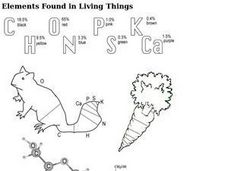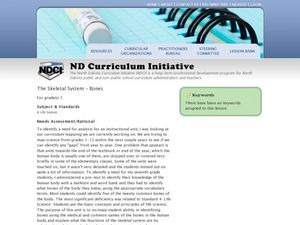Curated OER
STONEHENGE
Students work in cooperative groups to create a theory about the origin of Stonehenge. Each member of the group has a specific role, responsibilities and tasks. The group work can be implemented as a scaffolding technique.
Curated OER
Bringing the U.S. into World War II
Learners research and explore the cause and effects of global warfare. They assess the concept of the United States policy of isolationism as it involves the United States and Japanese relations. Each group of students prepare a time...
Curated OER
Plant Growth
Learners explore the parts of a plant and seed. They plant seeds and observe the growth of plants. Students record the observations. They discuss and share the observations they see.
Curated OER
And Your Point Is . . .? Part I
Students, in groups, complete a WebQuest titled "Love Canal Debate". They follow the WebQuest to research and write papers on different points of view regarding the Love Canal environmental disaster.
Curated OER
Soil, Forest, and Land Conservation
Students discuss the demands on the rainforest and devise a management plan that satisfies competing uses. They then construct a diorama to show the location of the various sites.
Curated OER
Great Questions for Tic Tac Toe
Fourth graders plan their own activities to reinforce the concepts being taught in school. The tic-tac-toe grid is used to help students create innovative learning activities to generate ideas.
Curated OER
Elements Found in Living Things
In this elements worksheet, students review the most common elements found in living things. Students color in two pictures with the percentages of the elements found in that living thing.
Curated OER
Probes, Exploration & Application
Students explore how a surface can be described without seeing it.
Curated OER
Natural Hazards
Students evaluate the hazards of naturally occurring events. After watching a video concerning safety hazards, students work in groups to discuss the safety issues involved in taking a trip to a mountainous region. Recommendations are...
Curated OER
Ecosystems
Sixth graders perform various labs, create presentations, and do hands on activities to explore the ecosystem.
Curated OER
Identification of Wildfire/Structure Interfaces, Risk Assessment of Structures, and Risk Management
Students participate in a class discussion about wildfire and urban interfaces as well as risk of wildfire in the area in which they live. After reviewing a wildfire/urban interface fire safety checklist, a walking field trip is...
Curated OER
Mussel Movements
Students consider the impact of invasive species on local environments. In this ecology lesson, watch the video, Arizona Wildlife Views, which focuses on invasive species. Students develop vocabulary, relate to meaningful comprehension...
Curated OER
Oceanography
Fifth graders study the topography of the ocean floor. They determine its ever changing nature as they examine currents and trade winds. They write paragraph describing how the winds might affect land formations after the discussion of...
Curated OER
Using My Nasa Data To Determine Volcanic Activity
Students use NASA satellite data of optical depth as a tool to determine volcanic activity on Reunion Island during 2000-2001. They access the data and utilize Excel to create a graph that has optical depth as a function of time for the...
Curated OER
Sea Surface Temperature Trends of the Gulf Stream
Students explore the importance of the Gulf Stream. Using a NASA satellite images, they examine the sea surface temperature. Students collect the temperature at various locations and times. Using spreadsheet technology, they graph the...
Curated OER
Kansas River: Where Do They Come From? Where Do They Flow? Which Ones Make the Kansas River Grow?
Students identify major rivers in Kansas, identify the direction which they flow and identify tributaries of the Kansas River. Students examine what occurrences upstream influence water quality downstream.
Curated OER
Sea Surface Temperature Trends of the Gulf Stream
Students use authentic satellite data to produce plots and graphs of sea surface temperature as they explore the seasonal changes of the Gulf Stream.
Curated OER
Date a Rock!
Young scholars figure the number of half-lives since the sample solidified, and therefore the "age" of the sample rocks.
Curated OER
Class Conservation Corps (CCC)
Students investigate how the loss of soil, a valuable natural resource, affects their lives through loss of productive land to grow food, loss of coastal land mass, and poor water quality from runoff. They design a project to keep soil...
Curated OER
Coastal Biodiversity of South Africa
Young scholars investigate the biodiversity found along the coast of South Africa. They conduct research using a variety of resources. They use the information in order to write lab reports with the data. The lesson plan can be adapted...
Curated OER
The Skeletal System - Bones
Seventh graders identify the common bones in the human body. In this biology instructional activity, 7th graders research two bones assigned to them. They explain why bones are important to us.
Curated OER
Vectors
Learners use both magnitude and direction to locate a place. They use locating techniques to make a temperature field of their classroom.
Curated OER
Investigate Non-native Neighborhood Invasion Species
Students investigate non-native species that are invading local or state environments. They choose one species to research and report on.
Curated OER
Glaciers Leave Their Imprint
Students study various types of glaciers and the landforms they create. Working in pairs, they research a type of glacial landform and construct a calendar page illustrating and describing it. The pages be compiled to create a class...
Other popular searches
- Concept Map in Science
- Concept Mapping in Science
- Life Science Concept Map
- Physical Science Concept Map
- Concept Maps Science
- Concept Map Science

























